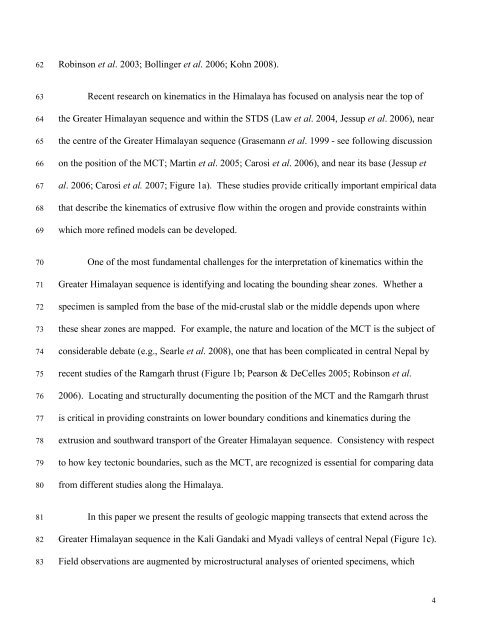Kinematics of the Greater Himalayan sequence, Dhaulagiri Himal ...
Kinematics of the Greater Himalayan sequence, Dhaulagiri Himal ...
Kinematics of the Greater Himalayan sequence, Dhaulagiri Himal ...
You also want an ePaper? Increase the reach of your titles
YUMPU automatically turns print PDFs into web optimized ePapers that Google loves.
62<br />
Robinson et al. 2003; Bollinger et al. 2006; Kohn 2008).<br />
63<br />
64<br />
65<br />
66<br />
67<br />
68<br />
69<br />
Recent research on kinematics in <strong>the</strong> <strong>Himal</strong>aya has focused on analysis near <strong>the</strong> top <strong>of</strong><br />
<strong>the</strong> <strong>Greater</strong> <strong><strong>Himal</strong>ayan</strong> <strong>sequence</strong> and within <strong>the</strong> STDS (Law et al. 2004, Jessup et al. 2006), near<br />
<strong>the</strong> centre <strong>of</strong> <strong>the</strong> <strong>Greater</strong> <strong><strong>Himal</strong>ayan</strong> <strong>sequence</strong> (Grasemann et al. 1999 - see following discussion<br />
on <strong>the</strong> position <strong>of</strong> <strong>the</strong> MCT; Martin et al. 2005; Carosi et al. 2006), and near its base (Jessup et<br />
al. 2006; Carosi et al. 2007; Figure 1a). These studies provide critically important empirical data<br />
that describe <strong>the</strong> kinematics <strong>of</strong> extrusive flow within <strong>the</strong> orogen and provide constraints within<br />
which more refined models can be developed.<br />
70<br />
71<br />
72<br />
73<br />
74<br />
75<br />
76<br />
77<br />
78<br />
79<br />
80<br />
One <strong>of</strong> <strong>the</strong> most fundamental challenges for <strong>the</strong> interpretation <strong>of</strong> kinematics within <strong>the</strong><br />
<strong>Greater</strong> <strong><strong>Himal</strong>ayan</strong> <strong>sequence</strong> is identifying and locating <strong>the</strong> bounding shear zones. Whe<strong>the</strong>r a<br />
specimen is sampled from <strong>the</strong> base <strong>of</strong> <strong>the</strong> mid-crustal slab or <strong>the</strong> middle depends upon where<br />
<strong>the</strong>se shear zones are mapped. For example, <strong>the</strong> nature and location <strong>of</strong> <strong>the</strong> MCT is <strong>the</strong> subject <strong>of</strong><br />
considerable debate (e.g., Searle et al. 2008), one that has been complicated in central Nepal by<br />
recent studies <strong>of</strong> <strong>the</strong> Ramgarh thrust (Figure 1b; Pearson & DeCelles 2005; Robinson et al.<br />
2006). Locating and structurally documenting <strong>the</strong> position <strong>of</strong> <strong>the</strong> MCT and <strong>the</strong> Ramgarh thrust<br />
is critical in providing constraints on lower boundary conditions and kinematics during <strong>the</strong><br />
extrusion and southward transport <strong>of</strong> <strong>the</strong> <strong>Greater</strong> <strong><strong>Himal</strong>ayan</strong> <strong>sequence</strong>. Consistency with respect<br />
to how key tectonic boundaries, such as <strong>the</strong> MCT, are recognized is essential for comparing data<br />
from different studies along <strong>the</strong> <strong>Himal</strong>aya.<br />
81<br />
82<br />
83<br />
In this paper we present <strong>the</strong> results <strong>of</strong> geologic mapping transects that extend across <strong>the</strong><br />
<strong>Greater</strong> <strong><strong>Himal</strong>ayan</strong> <strong>sequence</strong> in <strong>the</strong> Kali Gandaki and Myadi valleys <strong>of</strong> central Nepal (Figure 1c).<br />
Field observations are augmented by microstructural analyses <strong>of</strong> oriented specimens, which<br />
4

















